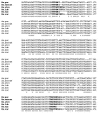Molecular identification of Palearctic members of Anopheles maculipennis in northern Iran
- PMID: 17233887
- PMCID: PMC1784096
- DOI: 10.1186/1475-2875-6-6
Molecular identification of Palearctic members of Anopheles maculipennis in northern Iran
Abstract
Background: Members of Anopheles maculipennis complex are effective malaria vectors in Europe and the Caspian Sea region in northern Iran, where malaria has been re-introduced since 1994. The current study has been designed in order to provide further evidence on the status of species composition and to identify more accurately the members of the maculipennis complex in northern Iran.
Methods: The second internal transcribed spacer of ribosomal DNA (rDNA-ITS2) was sequenced in 28 out of 235 specimens that were collected in the five provinces of East Azerbayjan, Ardebil, Guilan, Mazandaran and Khorassan in Iran.
Results: The length of the ITS2 ranged from 283 to 302 bp with a GC content of 49.33-54.76%. No intra-specific variations were observed. Construction of phylogenetic tree based on the ITS2 sequence revealed that the six Iranian members of the maculipennis complex could be easily clustered into three groups: the An. atroparvus-Anopheles labranchiae group; the paraphyletic group of An. maculipennis, An. messeae, An. persiensis; and An. sacharovi as the third group.
Conclusion: Detection of three species of the An. maculipennis complex including An. atroparvus, An. messae and An. labranchiae, as shown as new records in northern Iran, is somehow alarming. A better understanding of the epidemiology of malaria on both sides of the Caspian Sea may be provided by applying the molecular techniques to the correct identification of species complexes, to the detection of Plasmodium composition in Anopheles vectors and to the status of insecticide resistance by looking to related genes.
Figures




Similar articles
-
The Anopheles maculipennis complex (Diptera: Culicidae) in Iran: molecular characterization and recognition of a new species.Bull Entomol Res. 2003 Dec;93(6):527-35. doi: 10.1079/ber2003272. Bull Entomol Res. 2003. PMID: 14704099
-
Molecular characterization of the Anopheles maculipennis complex in the Islamic Republic of Iran.East Mediterr Health J. 2003 Jul;9(4):659-66. East Mediterr Health J. 2003. PMID: 15748063
-
Phylogenetic relationships of seven palearctic members of the maculipennis complex inferred from ITS2 sequence analysis.Insect Mol Biol. 1999 Nov;8(4):469-80. doi: 10.1046/j.1365-2583.1999.00140.x. Insect Mol Biol. 1999. PMID: 10634971
-
The Anopheles maculipennis complex (Diptera: Culicidae) in Germany: an update following recent monitoring activities.Parasitol Res. 2016 Sep;115(9):3281-94. doi: 10.1007/s00436-016-5189-9. Epub 2016 Jul 22. Parasitol Res. 2016. PMID: 27444437 Review.
-
A review of the use of ribosomal DNA (rDNA) to differentiate among cryptic Anopheles species.Insect Mol Biol. 1996 Feb;5(1):1-9. doi: 10.1111/j.1365-2583.1996.tb00034.x. Insect Mol Biol. 1996. PMID: 8630529 Review.
Cited by
-
Rapid discrimination between Anopheles gambiae s.s. and Anopheles arabiensis by High-Resolution Melt (HRM) analysis.J Biomol Tech. 2013 Apr;24(1):1-7. doi: 10.7171/jbt.13-2401-001. J Biomol Tech. 2013. PMID: 23543777 Free PMC article.
-
A standard photomap of ovarian nurse cell chromosomes in the European malaria vector Anopheles atroparvus.Med Vet Entomol. 2015 Sep;29(3):230-7. doi: 10.1111/mve.12113. Epub 2015 Mar 17. Med Vet Entomol. 2015. PMID: 25776224 Free PMC article.
-
The dominant Anopheles vectors of human malaria in Africa, Europe and the Middle East: occurrence data, distribution maps and bionomic précis.Parasit Vectors. 2010 Dec 3;3:117. doi: 10.1186/1756-3305-3-117. Parasit Vectors. 2010. PMID: 21129198 Free PMC article.
-
Molecular Characterization of Anopheles sacharovi Based on Sequences of ITS2-rDNA Region and COI Gene in North of Iran.J Arthropod Borne Dis. 2019 Jun 24;13(2):135-144. eCollection 2019 Jun. J Arthropod Borne Dis. 2019. PMID: 31803774 Free PMC article.
-
Larval habitats characterization and species composition of Anopheles mosquitoes in Tunisia, with particular attention to Anopheles maculipennis complex.Am J Trop Med Hyg. 2015 Mar;92(3):653-9. doi: 10.4269/ajtmh.14-0513. Epub 2015 Jan 5. Am J Trop Med Hyg. 2015. PMID: 25561567 Free PMC article.
References
-
- Falleroni D. Fauna anofelica italiana e suo "habitat" (paludi, risae, canali). Metodi di lotta contra la malaria. Riv Malariol. 1926;5:553–593.
-
- Van Thiel PH. Sur l'origine des variations de taille de 1'Anopheles maculipennis dans les Pays-Bas. Bull Soc Pathol Exot. 1927;20:366–390.
-
- White GB. Systematic reappraisal of the Anopheles maculipennis complex. Mosq Syst. 1978;10:13–44.
-
- Ribeiro H, Ramos HC, Pires CA, Capela RA. An annotated checklist of the mosquitoes of continental Portugal (Diptera, Culicidae) Congreso Ibérico de Entomologia. 1988;3:233–254.
Publication types
MeSH terms
Substances
Associated data
- Actions
- Actions
- Actions
- Actions
- Actions
- Actions
- Actions
- Actions
- Actions
- Actions
- Actions
- Actions
- Actions
- Actions
- Actions
- Actions
- Actions
- Actions
- Actions
- Actions
- Actions
- Actions
- Actions
- Actions
- Actions
- Actions
- Actions
- Actions
- Actions
- Actions
- Actions
- Actions
- Actions
- Actions
- Actions
LinkOut - more resources
Full Text Sources
Molecular Biology Databases
Miscellaneous

